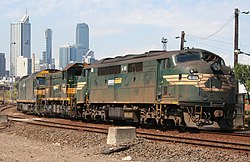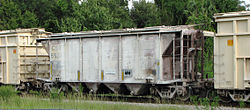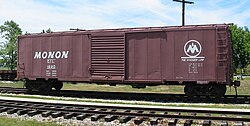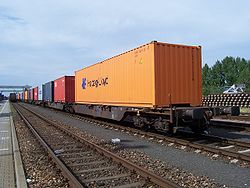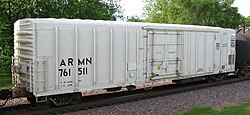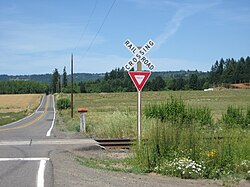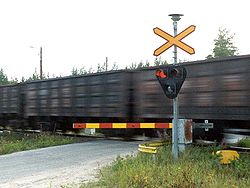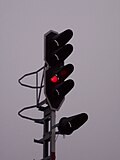AY Honors/Model Railroad/Answer Key
1. Give the history and development of model railroading.
Practical Beginnings
The development of model railroading runs, for the most part, parallel to the development of real-life (or 'prototype') railroading. The first model railroads appeared after 1810 and were one-of-a-kind creations used in designing or promoting their full-sized counterparts. Railroading was first developed to reduce the time and effort required to move raw materials or people over short distances made otherwise difficult by bad weather and poor roadways. The first rail cars were pulled along by animals, while steam-propelled machines, whether trains or automobiles, followed as quickly as the public was ready to adopt them. Various authors from diverse countries each lay different claims to the origins of both railroading and model railroading; and for this reason it is nearly impossible to reckon the precise date and location of the first model trains. By the 1830's, however, several countries including Germany, France, England and the United States were each developing steam-driven railroads to move freight and passengers. Original models of these first railroads are still on display in museums, and the first toy trains appeared not long after in German and British catalogs of the 1860's.
On the Right Track
The first toy trains of the 1840's actually ran on steam produced by filling the metallic model with water and placing in on a heating surface. These 'carpet railways' didn't use track and often left a trail of water behind them. In 1891, the German company Märklin began offering a track system for its wind-up, or "clockwork," trains which were moving along on their own electric power within the decade. The famous American toy train manufacturer, Lionel, began selling its first sectional three-rail electric train track (later called "Standard Gauge") in 1906, just five years after their first store window display called the "Electric Express" captured public attention. By 1910, the British company Bassett-Lowke had opened a London showroom exclusively for its model trains. Other early toy train producers from around the world were Lima, Bing, Fleischmann and Rivarossi.
The World's Greatest Hobby
Today, dozens of manufacturers from around the world sell their model railroading products via thousands of catalogs, magazines, websites and hobby stores. Model railroading has many fascinating aspects to attract people with many different interests and skill sets. Some modelers continue to make many things, even engines track and cars, from scratch, while a satisfying railroading experience can be gained from many ready-made sets available right out of the box. Called by many 'The World's Greatest Hobby', model railroading will doubtless continue to be a source of great enjoyment for many years to come.
2. Tell the difference in how the following prototype motive power units operate:
a. Steam
Steam powered locomotives use burning coal or wood to heat water enclosed in a large boiler. The steam released from this boiler acts much like the steam that emanates from a kettle of boiling water on the stove. By channeling the steam’s pressure into an engine cylinder, it pushes a piston that provides mechanical power to the wheels. Steam locomotives dominated rail transport until the mid-1900’s when diesel and electric locomotives took over. Steam locomotives had to stop periodically to receive a new supply of water plus logs or coal.
b. Diesel
Diesel locomotives burn diesel fuel in a combustion engine in virtually the same way as in the cars we use every day. The main difference between various types of diesel locomotives relates to how the power from its diesel engine is transferred to its drive wheels. Diesel locomotives were a great improvement over the steam locomotives in that they are quieter, cleaner, easier to maintain, and they can be started and stopped quickly, without the delay of waiting for water to boil. In mild weather, diesel engines don’t need to be left running to be ready to use at a moment’s notice, and diesel locomotives require far fewer people to operate them. Diesel locomotives continue to be used today.
c. Electric
Electric locomotives get power to turn their wheels from electric motors housed inside. Most such locomotives receive their electrical power from overhead wires or an additional rail running alongside the rails used by the wheels. Some electric locomotives employ onboard batteries to drive them. Electricity became the preferred way of driving trains that had to travel underground or through frequent tunnels because they produce no exhaust as diesel or gasoline engines do. Another advantage is that they are virtually silent when operating and are easier to maintain because they utilize fewer moving parts than mechanical combustion engines.
3. Know the name, scale, and track gauge for four model railroad gauges.
The six most popular scales used are: G scale, Gauge 1, O scale, H0 scale (in Britain, the similarly sized 00 is used), TT scale, and N scale (1:160), although there is growing interest in Z scale. H0 scale is the single most popular scale of model railroad. Popular narrow-gauge scales include HOn3 Scale and Nn3, which are the same scale as HO and N, except with a narrower spacing between the tracks (in these examples, a scale three feet instead of the 4'8.5" standard gauge).
The words scale and gauge seem at first to be used interchangeably in model railways, but their meanings are different. Scale is the model's measurement as a proportion to the original, while gauge is the measurement between the two running rails of the track.
| Name | Scale | Gauge |
|---|---|---|
| G scale | 1:22.5 | 45 mm |
| Gauge 1 | 1:32 | 44.45 mm |
| 0 scale | 1:43 or 1:48 | 32 mm |
| H0 scale | 1:87 | 16.5 mm |
| TT scale | 1:120 | 12 mm |
| N scale | 1:148 to 1:160 | 9 mm |
| Z scale | 1:220 | 6.5 mm |
4. Know the shapes and names of at least eight track plan arrangements.
Oval
The simplest layout for a model railroad and the starting point for most designs. In this design, two straightaway segments are connected by a semi-circle at each end. This is also the only layout which can easily be created with sectional track without the use of a manufacturer-specific design. Curved sectional track is sold by radii (half the distance across the semi-circle) and a box of such track sections will almost always create exactly half a circle. The two straightaway sections will usually utilize multiple pieces of sectional straight track, as desired by the modeler.
Figure-Eight
The second most common beginner's layout. This layout is best accomplished by purchasing it as a single set or following a manufacturer's layout design using their sectional track. The intersection in the center of the layout can either be accomplished by a piece of crossover track, or by elevating one track over the other. In the latter case, a set of piers or risers will be needed to raise the track at an appropriate rate.
Twice-Around
A modification of the figure-eight, in which one end-loop is contained within the other. The crossover here is not at 90° like in the basic figure-eight example and can be accomplished by using a alternately angled crossover piece or by using elevated track to pass one track over the other. The twice-around layout design allows the train to run continuously for longer than the simple oval before reaching its starting point.
Point-to-Point
This design does not allow a train to run continuously indefinitely, as you might imagine most plans would allow. However, this is the design that most closely resembles real-life railroad operation, since real-life railroads run across country, not in loops or circles. You can construct more elaborate yards at each end in order to enjoy the complexities of real-world operation.
Out-and-Back
This design approximates real-world operation, as each train must make a journey before it returns to the yard from which it originated. Although real freight never returns to its origin the same way it left, this arrangement does allows you to concentrate your time and resources on one yard instead of the two required in a Point-to-Point design (above).
Loop-to-Loop
This design diverges from realistic operation, but does allow the operator to interact with a continuous-running train. A yard can be added in the middle of the layout to simulate freight coming in from each direction. When modeling with two-rail scales, such as HO and smaller, special wiring will be required to insulate each loop from the rest of the line and allow the direction to be reversed on the mainline.
Dog Bone
This design is similar to the loop-to-loop design, but allows for continuous running without intervention from an operator. In addition, the two tracks running side-by-side simulate the double-track lines often seen in real life.
Twisted Dog Bone
This design is adds additional length to the mainline featured in the basic dog-bone design (above). Keeping one or both of the end-loops out of sight allows this layout to very realistically simulate the long distance running of a real railroad.
5. Know at least six points to check for the maintenance of a model railroading layout.
Cleaning & Checking Basic Trackwork
Most model railroads receive power for their electric motors through the tracks they run on. Thus, track must be kept clean and free of even the smallest obstructions. A train running on a dirty track does not operate smoothly or realistically, or may not run at all! The space between rails must also be maintained, though this is more of an issue when individual rails and ties have been laid down by hand. Sectional track usually maintains its proper gauge (space between the rails). Rail cleaning solution can be safely wiped across model track and track-cleaning cars are also available for running around the layout and cleaning hard-to-reach places.
Checking Wheels and Couplers
Locomotives and cars are kept rolling along together by various types of 'couplers.' These can be very tiny on the smaller model railroad scales, but in any case, they must be kept clean and properly hooked together for a train to run along smoothly. Another common problem is derailment when a car's wheels come off the track. This can also be harder to detect on smaller scale trains, but it will eventually get noticed as cars may tip completely off the track. Nevertheless, derailment is the most common operating problem encountered and should be one of the first possibility to check when things are going wrong.
Lubricating Engine Drive Mechanisms
Most model locomotives are powered by electric motors which involve a minimum of moving parts. There are typically tiny gears used in transferring the turning motor's power to the drive wheels of the locomotive. These are easily lubricated with special grease and/or oil available from a hobby supply store. Be careful to follow both the engine and lubricant manufacturers' instructions. Most wheels on other non-powered cars do not need to be oiled or greased except in rare cases.
Detailing Scenes & Structures
Model structures and landscape gather dust, making them look less realistic. These elements of a typical layout should be well anchored with adhesive when they are first installed so that their surfaces can be brushed clean, repainted, re-weathered and even vacuumed. In addition, its fun and rewarding to keep a layout fresh by installing new structures or creating new track-side scenes once your basic modeling is complete.
Testing Electrical Connections
Most model locomotives receive their power from the tracks below through one or more of their wheel sets. Since these wheels are turning, they transmit their power through stationary metal brushes that maintain contact with the tiny axle running between these wheels. These brushes should be kept clean and checked whenever an electrical problem is suspected. In addition, the wires which run from the operator's power pack to the rails themselves can become tangled, shorted out (when they inadvertently touch each other), or disconnected all leading to potential breakdown in the power supplied to the model railroad. A simple electric meter available from a hobby or electronics store can help determine where a breakdown is occurring by testing (1) the output of the power pack directly, (2) the presence of power on the set of tracks where the train is located, or (3) at any control point in between, such as when a control panel switch is used to control power to different track sections.
Adjusting Turnouts, Switch Machines & Ground Throws
Turnouts (sometimes called 'switches') are used to send a train from one set of track to another. These are easy places for trains to become derailed because the wheels must pass over a series of changeable mechanical parts that are more complex than the simple two (or three) rails used elsewhere in the layout. The 'points' of a switch are moved between two different resting positions which determine what path the trail will take after it passes through the turnout. These points must rest securely against either the inside or outside rail and must not move otherwise. If the points are moved remotely, by an electrical signal sent from the control panel to a 'switch machine' next to the turnout, then this switch machine and its associated wiring must be in good working order. If the switch is operated by hand using a small lever or 'ground throw' next to the turnout, then the ground throw needs to be kept clean and lubricated and able to move the points the full distance between their two desired positions.
6. Identify and explain the use of:
a. Five types of freight cars
Covered Hopper
Structurally, a covered hopper is very similar to an opentop hopper car. What distinguishes this type of car from an open hopper is the car's roof, and also the car's overall size. Covered hoppers typically carry loads of less dense, and therefore lighter, materials, so they are built to a higher cubic capacity than open top hoppers.
Box Car
A boxcar (the American term; the British call this kind of car a "goods van" while in Australia, they are usually referred to as "louvre vans") is a railroad car that is enclosed and generally used to carry general freight. The boxcar, while not the simplest freight car design, is probably the most versatile, since it can carry most loads. Boxcars have side doors of varying size and operation, and some include end doors and adjustable bulkheads to load very large items.
Container Car
Containerization is a system of intermodal freight transport cargo transport using standard ISO containers known as shipping containers that can be loaded and sealed intact onto container ships, railroad cars, planes, and trucks. The introduction of containers resulted in vast improvements in port handling efficiency, thus lowering costs and helping lower freight charges and, in turn, boosting trade flows. Almost every manufactured product humans consume spends some time in a container.
Flat car
A flatcar (also flat car) is a piece of railroad rolling stock that consists of an open, flat deck on four or six wheels or a pair of trucks (US) or bogies (UK). The deck of the car can be wood or steel, and the sides of the deck can include pockets for stakes or tie-down points to secure loads. Flatcars designed for carrying machinery have sliding chain assemblies recessed in the deck. Flatcars are used for loads that are too large or cumbersome to load in enclosed cars such as boxcars. They are also often used to transport containers or trailers in intermodal shipping.
Gondola
A gondola is an open-top type of rolling stock that is used for carrying loose bulk materials. Because of its low side walls, gondolas are used to carry either very dense material, such as steel plates or coils, or bulky items such as prefabricated pieces of rail track.
Refrigerator Car
A refrigerator car (or "reefer") is a refrigerated boxcar, a piece of railroad rolling stock designed to carry perishable freight at specific temperatures. Refrigerator cars differ from simple insulated boxcars and ventilated boxcars (commonly used for transporting fruit), neither of which are fitted with cooling apparatus. Reefers can be ice-cooled, come equipped with any one of a variety of mechanical refrigeration systems, or util
Stock Car
In railroad terminology, a stock car is a type of rolling stock used for carrying livestock (not carcasses) to market. A traditional stock car resembles a boxcar with slats missing in the car's side (and sometimes end) for the purpose of providing ventilation; stock cars can be single-level for large animals such as cattle or horses, or they can have two or three levels for smaller animals such as sheep, pigs, and poultry.
Tank Car
A tank car is a type of railroad rolling stock designed to transport liquid and gaseous commodities. Outside of North America, they are also known as tank wagons or tanker wagons.
b. Three types of passenger cars
c. Three types of steam engines according to their wheel arrangement
d. Two types of grade crossing warning devices
Uncontrolled Crossings
"Open" or "Uncontrolled" crossings utilize a sign with or without flashing lights and an audible bell warning. These are considered 'open' because there is no barricade to the passage of pedestrians or traffic. In America, the 'crossbuck' is most typically seen at graded crossings. This is the familiar white "X" shape with the words "RAILROAD" and "CROSSING" printed on them.
Controlled Crossings
The most typical method of controlling a railroad crossing is with automatic close-able gates. These are accompanied by the flashing lights and warning bell, but make it difficult for cars or pedestrians to cross the tracks when they are down.
e. Two types of railroad signals
Mechanical Semaphore Signals
Mechanical semaphores utilize a moveable arm (or 'blade') whose position indicates how approaching trains may proceed. A set of differently colored lenses are also mounted on the arm, each passing in front of a stationary light when the arm moves, so that the semaphore can effectively signal trains at night.
Colored Light Signals
These signals control train movements by displaying one of several colors of lights. They can also position the lights differently in order to send additional information to the engineer.
7. Know the meaning of the following model railroad terms:
- a. Ballast
- b. Blind drivers
- c. Block
- d. Bolster
- e. Crossing
- f. Crossover
- g. Double header
- h. Draft gear
- i. Flange
- j. Frog
- k. Gap
- l. Gauge
- m. Grade
- n. Gravity yard
- o. Hot box
- p. Insulated rail joiner
- q. Journal
- r. Layout
- s. Mainline
- t. Prototype
- u. Rail joiner
- v. Reverse loop
- w. Siding
- x. Spur
- y. Switch
- z. Machine
- aa. Talgo truck
- bb. Truck
- cc. Turnout
- dd. Two-rail
- ee. Wye
- ff. Yswitch
- gg. Yard
